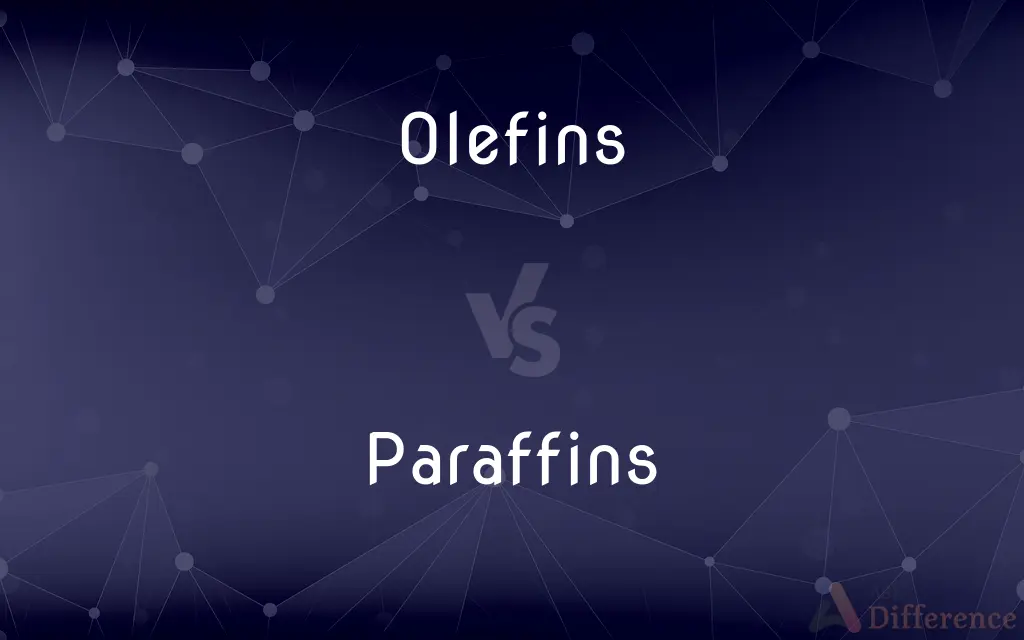Olefins vs. Paraffins — What's the Difference?
By Tayyaba Rehman & Urooj Arif — Published on February 17, 2024
Olefins, also known as alkenes, are hydrocarbons with one or more double bonds between carbon atoms, making them unsaturated. Paraffins, or alkanes, are saturated hydrocarbons with single bonds between carbon atoms.

Difference Between Olefins and Paraffins
Table of Contents
ADVERTISEMENT
Key Differences
Olefins and paraffins represent two fundamental classes of hydrocarbons, distinguished by their bonding structure and saturation level. Olefins, characterized by the presence of at least one carbon-carbon double bond, are unsaturated hydrocarbons. This double bond introduces reactivity, allowing olefins to participate in a wide range of chemical reactions, including polymerization and addition reactions. Olefins are crucial in the petrochemical industry for producing polymers, plastics, and synthetic rubber.
Paraffins, in contrast, are saturated hydrocarbons with single bonds between all carbon atoms. Their structure makes them relatively non-reactive compared to olefins. Paraffins are found abundantly in crude oil and natural gas and are used extensively as lubricants, in candles, and for making other chemicals. Their saturated nature contributes to their stability, making them preferred as fuel sources in various applications.
The chemical properties of olefins and paraffins lead to their diverse applications in the industrial sector. Olefins, with their ability to form long polymer chains, are essential in manufacturing a wide array of synthetic materials. Paraffins, due to their non-reactive nature, serve well in applications requiring stable, long-lasting hydrocarbon products.
Moreover, the difference in reactivity between olefins and paraffins underlies their role in chemical synthesis. Olefins, being more reactive, are often key intermediates in the synthesis of complex molecules. In contrast, paraffins are less commonly involved in such processes due to their chemical inertness.
In summary, while both olefins and paraffins are vital hydrocarbons with wide-ranging applications, their distinct chemical structures confer different properties and reactivities, making them suitable for varied uses in the chemical, petrochemical, and consumer product industries.
ADVERTISEMENT
Comparison Chart
Bonding Structure
At least one double bond between carbon atoms
Only single bonds between carbon atoms
Saturation
Unsaturated hydrocarbons
Saturated hydrocarbons
Reactivity
More reactive, participates in addition reactions
Less reactive, chemically stable
Applications
Used in producing polymers and chemicals
Used as fuels, lubricants, and in wax production
Industry Use
Petrochemical synthesis, plastics manufacturing
Energy sector, candle making, lubricant production
Compare with Definitions
Olefins
Olefins are unsaturated hydrocarbons with carbon-carbon double bonds.
Ethylene, a simple olefin, is a key raw material in the production of polyethylene.
Paraffins
Major components of natural gas and oil.
Methane, the simplest paraffin, is the primary component of natural gas.
Olefins
Essential in the petrochemical industry.
Propylene, an olefin, is used to make polypropylene plastics.
Paraffins
Chemically stable and less reactive.
Paraffins are preferred as lubricants due to their stability.
Olefins
Found in crude oil and natural gas.
Olefins are extracted from crude oil through the cracking process.
Paraffins
Used as fuels for their high energy content.
Liquid paraffin is used as a fuel in heaters and lamps.
Olefins
Reactive due to their double bonds.
Olefins readily undergo addition reactions, making them versatile in chemical synthesis.
Paraffins
Paraffins are saturated hydrocarbons with single bonds between carbons.
Paraffin wax is used in candles for its stable burn properties.
Olefins
Can form polymers.
Butene is an olefin that polymerizes to form butene copolymers.
Paraffins
A waxy white or colorless solid hydrocarbon mixture used to make candles, wax paper, lubricants, and sealing materials. Also called paraffin wax.
Olefins
Any of a class of unsaturated open-chain hydrocarbons having at least one double bond.
Paraffins
(Chemistry) A member of the alkane series.
Olefins
A fiber or fabric made of this material.
Paraffins
Chiefly British Kerosene.
Paraffins
To saturate, impregnate, or coat with paraffin.
Paraffins
Plural of paraffin
Paraffins
Infl of paraffin
Paraffins
Serve as a base for many cosmetic products.
Paraffin oil is commonly found in lotions and creams.
Common Curiosities
Why are paraffins considered stable?
Their saturated structure with single bonds makes them chemically less reactive.
How are paraffins extracted?
Paraffins are extracted from crude oil and natural gas through distillation and refining processes.
What is the significance of olefins in the petrochemical industry?
Olefins are key intermediates in producing a wide range of chemicals and materials.
Can olefins be converted into paraffins?
Yes, through hydrogenation, olefins can be converted into paraffins by adding hydrogen to double bonds.
Are paraffins environmentally friendly?
While paraffins are stable and widely used, their environmental impact depends on their source and use.
How does the reactivity of olefins compare to paraffins?
Olefins are more reactive due to their double bonds, whereas paraffins are less reactive.
What makes olefins essential in plastics manufacturing?
Their ability to polymerize and form long chains makes them foundational in plastics production.
What role do olefins play in polymerization?
Olefins, like ethylene and propylene, are monomers that polymerize to form important plastics.
What are olefins used for?
Olefins are used to manufacture polymers, plastics, and synthetic rubber.
Can paraffins be used in food?
Yes, food-grade paraffin wax is used in coating cheeses and candies to prevent spoilage.
How are paraffins used in the energy sector?
They are used as fuels due to their high energy content and stability.
Are paraffins renewable?
Paraffins derived from petroleum are not renewable, but bio-based paraffins are being developed.
What are the environmental concerns associated with olefins?
Concerns include their production process and the non-biodegradability of products made from them.
Why are olefins important in synthetic rubber production?
Their chemical reactivity allows for the creation of various synthetic rubbers with specific properties.
How does the double bond in olefins affect their properties?
The double bond increases reactivity, making olefins versatile for chemical synthesis and polymer production.
Share Your Discovery

Previous Comparison
Fire Red Pokemon vs. Leaf Green Pokemon
Next Comparison
Last vs. The LastAuthor Spotlight
Written by
Tayyaba RehmanTayyaba Rehman is a distinguished writer, currently serving as a primary contributor to askdifference.com. As a researcher in semantics and etymology, Tayyaba's passion for the complexity of languages and their distinctions has found a perfect home on the platform. Tayyaba delves into the intricacies of language, distinguishing between commonly confused words and phrases, thereby providing clarity for readers worldwide.
Co-written by
Urooj ArifUrooj is a skilled content writer at Ask Difference, known for her exceptional ability to simplify complex topics into engaging and informative content. With a passion for research and a flair for clear, concise writing, she consistently delivers articles that resonate with our diverse audience.
















































